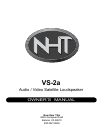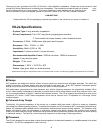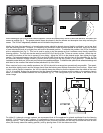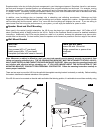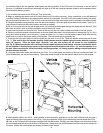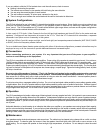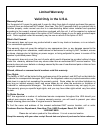
If you are unable to slide the VS-2a brackets down onto the wall screws, check to ensure:
z Nothing is obstructing the speaker
z The brackets are mounted on the speaker with both facing the same direction
z You are using the correct keyhole on each bracket
z The wall screws are exactly 16 inches apart, centered on the studs
z There is enough room between the screw head and the wall for the bracket to slide down.
System Configurations
The VS-2a is optimized for use in the latest 5.1-channel discrete digital surround systems. Since digital surround soundtracks are
mixed as five discrete channels, uniform tonality in the playback system is essential for achieving a believable “you are
there” sound. The VS-2a satellites and VT-2 towers utilize identical upper range drivers, so there are two system configurations
that will each provide matched timbre to all five channels:
1- Use a pair of VT-2 Audio / Video Towers for the front left and right speakers and three VS-2a’s for the center and rear
speakers. Configure all low frequencies to be sent to the VT-2’s. Since the VT-2’s have built-in subwoofers, a separate
subwoofer is an option and not a necessity in this system.
2- Use five VS-2a’s (front left, center and right, rear left and right) and a separate powered subwoofer (NHT SW1P, SW2Pi
or SW3P) for the low frequency effects channel.
For a no-holds-barred home theater system starting with either of the above configurations, powered subwoofers may be
employed on any or all five channels to provide balanced bass and increased impact.
Connections
Before connecting speakers to your system, it is very important that you turn off the power to your amplifier /
receiver to avoid damage to the equipment.
The VS-2a is compatible with virtually all quality amplifiers. Proper wiring of the speaker is essential to good sound. At a minimum,
16 AWG speaker cable is recommended for runs of 10 feet or less, with 14 AWG cable used for larger runs. For specialty cable con-
siderations, consult your local authorized NHT retailer. For best results, use equal length runs of cable for all three front speakers.
Prepare your cable by stripping 1/4” to 3/8” of insulation from the ends and twisting the exposed wire strands tightly. The five-way bind-
ing posts on the back of the speaker will accept raw wire, banana plugs, or spade plugs. Tighten the binding posts by hand, as pliers
can strip or break them.
Be sure to wire all the speakers “in-phase.” That is, the Positive (red) terminal on the amplifier output must be connected
to the corresponding Positive (red) terminal on the speaker. Likewise with the Negative (black) terminals. All speaker wires
have some sort of marking along one or both conductors to help you make the correct connections. Incorrect speaker phase is
indicated by weak bass and the lack of a well-defined stereo image.
To minimize noise pickup, segregate cables by function. Do not run low level signal cables parallel to power cables, speaker cables,
or digital cables. Also, do not run speaker cables or digital cables parallel to power cords or parallel to each other. If different types of
cables are placed near each other at some place in your system, separate them by the maximum practical distance and cross them
at right angles where they meet. Do not twist or tie AC power cords with speaker cables.
Operation
The VS-2a was designed to handle a wide range of listening levels, but every speaker has limits. It is important to use common sense
and listen for signs of possible distress from the speakers. Underpowered amplifiers are most often the cause of speaker damage.
For example, a 60-watt amplifier runs out of power when called upon to produce more than 60 watts, and the resulting distortion can
damage the speaker. If you tend to listen at high voumes, more powerful amplifiers are preferable because they are less likely to run
out of power.
Noticeable distortion or harsh breakup is an indication that either your amplifier or your speakers are running beyond their capacity,
and the volume should be decreased. If you can feel any heat emanating from the woofer or tweeter, reduce the level immediately.
Speaker damage most often occurs from sustained high volume levels, not from transient sounds or brief musical peaks. Excessive
boosting of bass, treble or equalizer controls can worsen the problem, and is not recommended.
Maintenance
Your speakers require minimal maintenance under normal use. The cabinet may be cleaned using a damp cloth or a mild, non-abra-
sive glass cleaner. To clean the grille, first remove it from the speaker, then brush lightly with a soft brush or use a vacuum on its
lowest setting. Do not expose the speaker to direct sunlight, high temperatures, or moisture. Do not attempt to clean the actual
drivers.
6



